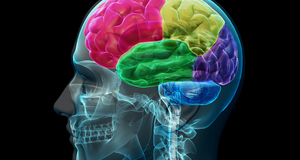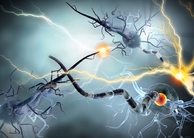From Discussions VOL. 11 NO. 1How the Electrical Activity and Synaptogenesis of Neurons Contribute to the Efficacy of Neurofeedback TherapyElectrical Activity of Neurons and SynaptogenesisSynaptic interactions as well as their respective strengths and input signals contribute to setting the conditions necessary for oscillatory neuronal behavior, more commonly known as brainwaves, to occur. According to Lopes da Silva’s observations, where neurons had synergistic oscillations in the beta frequency range, there were patches of enhanced correlations. Because oscillatory effects appear to be a highly effective manner of activating large populations of neurons (Lopes da Silva, 1991), it can be reasoned that, along the lines of Hebb’s postulate, these neurons “fire together” and “wire together”, thus facilitating the pattern of electrical conductance in the future. It has been shown that electrical activity within an axon can modulate its myelination over a period of weeks (Ghaziri, et al, 2013), so it can be theorized that focusing on achieving a particular brainwave, for prolonged periods of time, the most common of which is around 30-40 minutes for NFT (Ghaziri, et al 2013), can induce an increase in white matter. Ghaziri, et al. used an NFT protocol that called for three sessions per week, at 30 minutes each, for 13.5 weeks. By comparing the results of the con group (no neurofeedback, and no guidance from researcher), sham group (fake neurofeedback, and guidance from researcher), and experimental group (accurate neurofeedback and guidance from researcher), it was found that NFT led to a significant increase in both white and gray matter. EEG was used for the neurofeedback, while MRI was used to image both white and gray matter volume, and dMRI was used to more specifically examine the white matter. The idea that the electrical activity of neurons within the CNS affects the myelination of axons, and thus the volume of white matter, is further supported by studies that show that myelin can be inhibited or enhanced by either blocking the action potentials of neighboring axons, or by enhancing their electrical activity. Administration of tetrodotoxin (TTX), and action potential inhibitor, can also induce a dramatic inhibition of the level of myelination, and its subsequent removal allows for recovery of electrical activity that allows myelination to proceed again (Demerens, 1996). Any type of sensory experience alters the brain in some way. However, it has been shown that experiencing repeated neurofeedback therapy can induce measurable, morphological changes. Alterations in gene expression and the physiology of the associated neurons often accompany environment-induced reorganization of brain connectivity. This all goes hand in hand with the evidence supporting that electrical activity influences neuroplasticity. Because action potentials cause the release of neurotransmitters, and these neurotransmitters often trigger second messenger cascades within the cell that ultimately affect gene expression, it is very possible that changing patterns of electrical activity can alter genes. In fact, several activity dependent axon signals have been proposed to initiate myelination, including ATP and the neurotransmitters glutamate (Butt and Tutton, 1992). The results that show increases in both white and gray matter from Ghaziri et. al. support that neuroplasticity remains possible well into adult life – a relatively new concept given that not too long ago people believed the brain to be analogous to a computer and unable to change. The change observed in gray matter is thought to be due to synaptogenesis, or the formation of new synapses. It has been shown that experience can modify the morphology of synapses and contribute to the formation of new ones or loss of old ones (Marham, 2004), so neurofeedback therapy could very well function in this way. Furthermore, changing the shape of dendritic spines can often influence a change in their conductive properties (Markham, 2004), which could ultimately tie into the subsequent modification of myelination. This possibility implies that changes in gray matter can influence changes in white matter. Brain-derived neurotrophic factor (BDNF) also likely plays a role in the neuroplasticity accompanying NFT. Referring back to the brains of the mice housed in enriched environments, along with their increased numbers of hippocampal neurons, it has been found that these rats also showed increased levels of BDNF. Though the correlational relationship has been found, the causational relationship between BDNF and neurogenesis is still being determined. However, Markham and Greenough found that BDNF is critical for use-dependent synaptic plasticity, and Mizuno et al have found that it regulates both short and long-term potentiation (Mizuno, 2007). This data all support the idea that neurofeedback therapy works by causing changes in white and gray matter that are due to neuroplasticity, which is generated by a myriad of biological mechanisms. ConclusionThe neuroplasticity thought to underlie the clinical efficacy of neurofeedback therapy is likely due to synaptogenesis and varied electrical activity of neurons. This review intended to analyze the relationship between how neurofeedback therapy is conducted and the neural substrates underlying how and why it works. By examining a variety of research articles, it can be concluded that NFT has concrete biological underpinnings that are slowly but surely becoming elucidated. A more thorough understanding of how this therapy works should lead to an increase in its popularity, and hopefully an increase in precision of treatment methods. The implications of this type of therapy are vast and appear highly beneficial in clinical settings. The risks are much lower and the benefits much longer-term than pharmaceutical or surgical therapies. The brain has an amazing ability to adapt and change itself to environmental demands, and NFT aims to utilize this. Research in this field should continue towards gaining a deeper understanding of how neurofeedback works in the brain and how to accurately use it to manipulate neuroplasticity. It should also examine how pharmaceuticals might be able to enhance the effects of NFT, and how NFT can enhance pharmaceutical use or recovery after surgery. By doing so, the amount of clinical therapies to choose from when faced with ailments of the brain will be greatly expanded. AuthorSabrina Perry is a senior studying Neuroscience with a minor in Spanish at the University of California, Santa Barbara. She spent time as a research assistant in Dr. Tod Kippin’s lab and has been involved in the club Triathlon Team throughout her entire college career. She will be applying to Doctor of Physical Therapy (DPT) programs in the fall and hopes to specialize in neurologic PT so that she can find ways to bring neuroscientific advancements into clinical use. ReferencesBasar, E., et al. (1997) Alpha oscillations in brain functioning: an integrative theory. International Journal of Psychophysiology, 26: 5-29. Bressler, S.L., (1990). The Gamme Wave: a Cortical Information Carrier? TINS, 13 (5): 161-162. Butt and Tutton, (1992). Response of oligodendrocytes to glutamate and gamma-aminobutyric acid in the intact mouse optic nerve. Neuroscience Letters, 146: 108-110. Cole, H.W., Ray, W.J., (1985). EEG Alpha Activity Reflects Attentional Demands, and Beta Activity Reflects Emotional and Cognitive Processes. Science, 228: 770-752. deCharms, R.C., (2007). Reading and controlling human brain activation using real-time functional magnetic resonance imaging. TRENDS in Cognitive Sciences, 11(11): 473-481. Demerens, C. (1996) Induction of myelination in the central nervous system by electrical activity. Neurobiology, 93: 9887-9892. Fetz, E.E., (2007). Volitional control of neural activity: implications for brain-computer interfaces. Journal of Physiology, 579.3:571-579. Ghaziri, J. et al. (2013) Neurofeedback Training Induces Changes in White and Gray Matter. Clinical EEG and Neuroscience, 44: 1-7. Hagmann, et al. (2006) “Understanding Diffusion MR Imaging Techniques: From Scalar Diffusion-weighted Imaging to Diffusion Tensor Imaging and Beyond,” RadioGraphics. 26:1. Hollingworth, W., et al. The Diagnostic and Therapeutic Impact of MRI: an Observational Multi-centre Study. Clinical Radiology, 55 (11) 825-831. Huttel, S.A., Song, A.W., McCarthy, G. (2009), Functional Magnetic Resonance Imaging, Massachusetts: Sinauer, ISBN 978-0-87893-286-3. Kempermann, G., Kuhn, G., Gage, F. (1997) More hippocampal neurons in adult mice living in an enriched environment. Nature, 386: 493-497. Le Bihan, D., et al (1986) MR Imaging of intravoxel coherent motions: application to diffusion and perfusion in neurologic disorders. Radiology, 161(2): 401-407. Lopes de la Silva, F., (1991) Neural mechanisms underlying brain waves: from neural membranes to networks. Electroencephalography and clinical Neurophysiology, 79: 81-93. Markham, J.A., Greenough, W.T., (2004) Experience-driven brain plasticity: beyond the synapse. Neuron Glia Biology, 1(2): 351-363. Mizuno, M. et al (2007) Involvement of Brain-Derived Neurotrophic Factor in Spatial Memory Formation and Maintenance in a Radial Arm Maze Test in Rats. The Journal of Neuroscience, 20(18): 7116-7121. Monastra, V.J., Monastra, D.M., George, S. (2002) The Effects of Stimulant Therapy, EEG Biofeedback, and Parenting Style on the Primary Symptoms of Attention-Deficit/Hyperactivity Disorder. Applied Psychophysiology and Biofeedback, 4: 231-247. Niedermeyer E. and da Silva F.L. (2004). Electroencephalography: Basic Principles, Clinical Applications, and Related Fields. Lippincot Williams and Wilkins. ISBN: 0-7817-5126-8. Suggested Reading from Inquiries Journal
Inquiries Journal provides undergraduate and graduate students around the world a platform for the wide dissemination of academic work over a range of core disciplines. Representing the work of students from hundreds of institutions around the globe, Inquiries Journal's large database of academic articles is completely free. Learn more | Blog | Submit Latest in Neuroscience |

















